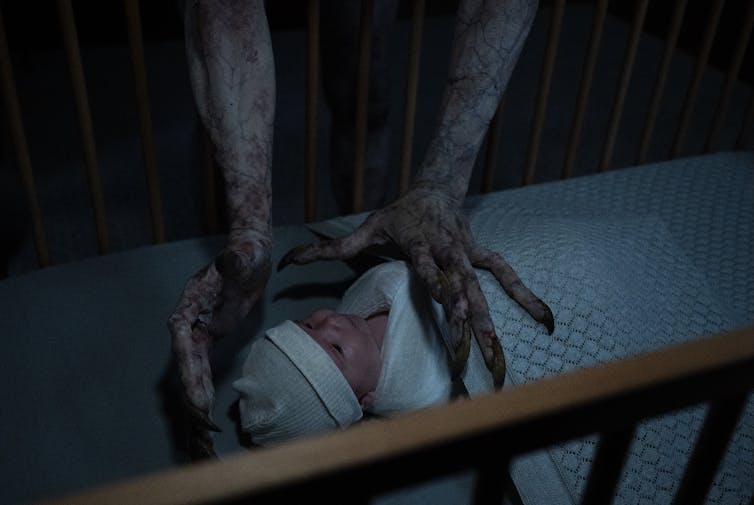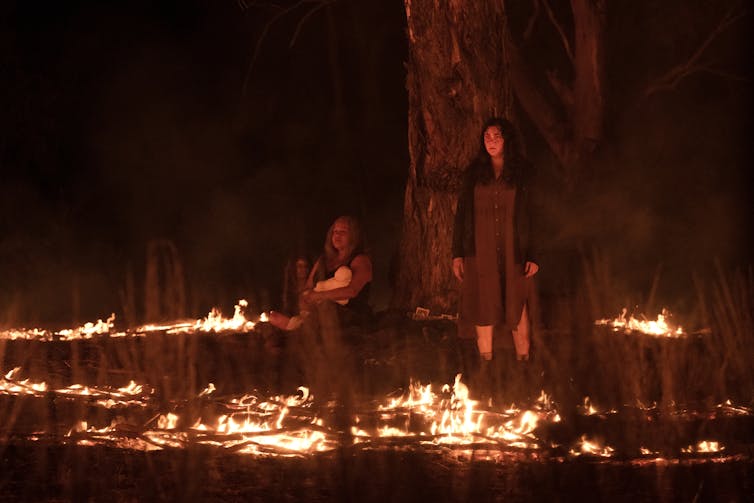
Isn’t raising one’s child supposed to be full of joy and laughter? Apparently not, according to the horror genre.
Consider Mary Shelley’s Frankenstein (1818), one of the earliest and most famous horror novels ever written. It follows a father-like character who creates a child-like progeny, and the former’s failure to love the latter turns the nameless creature into a “monster” in more ways than one.
Australia is a noteworthy contributor to the sub-genre of parental horror. The Babadook (2014), Relic (2020) and Lake Mungo (2008) are just some Aussie horror films that feature terrified (or terrifying) mums and dads.
The first half of Jon Bell’s The Moogai made me think it could be in the running for the title of Ultimate Aussie Horror Flick. It is a certifiably Australian horror film. It is also one of very few Indigenous-directed horror films, alongside Tracey Moffatt’s 1993 experimental triptych beDevil.
Bell’s past credits include work in horror’s sister genre, sci-fi, including for co-writing the script of the acclaimed TV series Cleverman. As with this show, his directorial debut feature fuses a figure from Indigenous spiritual traditions with the modern genre conventions.

Being followed by a bad spirit
The titular figure at the centre of The Moogai is a “bad spirit” from Indigenous lore – “something akin to the boogie man,” Bell said in an interview.
We first encounter the Moogai – or at least become aware of his ominous presence – in the film’s introductory sequence which recalls the trauma of the forced removals of the Stolen Generations.
In these scenes, set in 1970, an Indigenous girl runs into a cave in a rural setting to hide from government agents. She and the audience soon realise something very threatening already resides in the cave.
We hear some heavy breathing, a growl, the girl’s scream and then … cut to 2024, to a posh corporate function in the city, where a bottle of champagne is being uncorked. It’s a terrifically startling cut, and Bell’s incisive use of montage throughout the film is just one facet of his skills as a highly visual filmmaker.
In one of the most wonderfully disturbing scenes, the protagonist Sarah (Shari Sebbens), not long after having given birth to her second child, cracks open an egg in the kitchen to make breakfast. Inside is a bloody chicken embryo. Unsettled, Sarah throws the egg’s contents in the kitchen sink, but the glistening embryo is alive; it opens its beak and pecks at her fingers.
This scene of fertility gore succinctly and excellently conveys the film’s central source of horror. Sarah, a successful corporate lawyer, has a Lazarus moment while giving birth. During a brief otherworldly sojourn, the Moogai enters her life to do what the Moogai apparently are known to do: steal children.
Soon, Sarah’s petrified daughter Chloe (Jahdeana Mary) is mumbling about having seen “that man with the long arms”. Sarah’s estranged biological mother, Ruth (played by a forceful and fascinating Tessa Rose), counsels Chloe: “you look out for that Moogai, baby girl.”

Bloodless and thematically heavy
There’s a clear allegorical, or perhaps metaphorical, association between the demonic entity in The Moogai and the lurid racial policies of Australian governments with regards to the Indigenous. At the same time, the film is careful not to overstate or oversimplify its figurative qualities.
Sarah is, to be sure, an Indigenous woman fearing for the safety of her children, but she’s not a simple or stereotypical victim. She’s proudly bourgeois, supremely self-important and unabashedly horrible towards those who earn less money than her, including the long-suffering Ruth.
The Moogai is as much about class – and the horror wealthy folk have of things not always going their way – as it is about maternity, Indigeneity, mental illness and intergenerational conflict.
It is perhaps due to the these hefty topics that the film starts to become, as it were, somewhat weighty in its second half. While it maintains a degree of dread and includes a few scary moments, its interest in horror recedes. There are, much to my sadness, no scenes of blood and gore – not even when the minor character Ray Boy (Clarence Ryan) is primed to get mauled by the Moogai.

A toned-down approach to horror
The final confrontation between the three generations of women and their ghostly tormentor strikes me as something from a fantasy or superhero movie. It seems, for whatever reason, the filmmakers decided to tone down the horror and opt for a restrained offering with an exceedingly positive and heart-warming ending.
This is a shame, really. If The Moogai had embraced the genre’s darker, more shocking aesthetics, it could have easily earned its place not only alongside recent Australian instant classics such as Talk to Me (2022), but also the year’s best horror films such as The Substance. But it has ultimately settled for a fairly bloodless tale of parental paranoia and cultural dissociation.
I’m confident viewers who appreciate serious movies with serious themes would approve of the film’s second half. But would these folk deign to see anything that resembles “horror” to begin with?
Here’s hoping the indisputably talented Jon Bell will continue to work in the genre – and engage with it more wholeheartedly in the future.

The Moogai is out in cinemas from October 31.
Ali Alizadeh does not work for, consult, own shares in or receive funding from any company or organisation that would benefit from this article, and has disclosed no relevant affiliations beyond their academic appointment.
This article was originally published on The Conversation. Read the original article.







